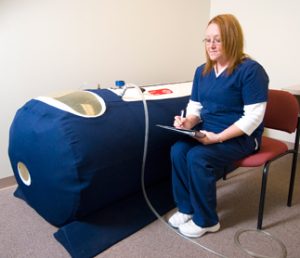Hyperbaric Oxygen Therapy (HBOT) applications can be broadly divided into two categories, emergency conditions (acute) and chronic conditions. The emergency applications take advantage of Hyperbaric Oxygen Therapy’s (HBOT’s) ability to stop inflammation, infection, and tissue destruction and oxygenate tissues that are starved for oxygen.
Acute Conditions
These acute conditions include decompression sickness (“the bends”), air embolism (air in the arteries of the body due to a rupture of the lungs in diving or accidental injection of air during medical procedures), carbon monoxide poisoning, burns, the flesh-eating bacteria, gas gangrene (occurs in trauma and war wounds), surgical flaps and grafts that are failing due to low oxygen and blood supply, massive loss of blood where transfusion is not possible (e.g., Jehovah’s Witnesses), brain abscesses, crush injury, sudden loss of vision due to a blood clot in the main artery to the eye, and acute loss of blood supply to an arm or leg due to blood vessel disease or trauma (accidental amputation). In all of these conditions, Hyperbaric Oxygen Therapy (HBOT) should be applied as soon as possible after the injury or insult or at the start of the infection. When delivered emergently, Hyperbaric Oxygen Therapy (HBOT) can be life and limb saving.
Chronic Conditions
The other category of applications is chronic or stable conditions. In these conditions, Hyperbaric Oxygen Therapy (HBOT) stimulates the growth of new tissue in damaged areas of the body. It does this by causing release of growth and repair hormones. These conditions include radiation wounds, chronic bone infections, and non-healing wounds of any type such as diabetic foot wounds, venous stasis wounds of the legs, or wounds due to inflammation of the blood vessels such as in rheumatoid arthritis and autoimmune conditions. In most of these disorders, Hyperbaric Oxygen Therapy (HBOT) heals by causing the growth of tiny new blood vessels.
Source: altmd.com

